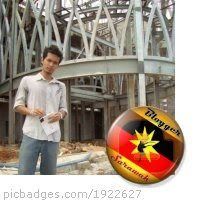


( Government House as now knowns as Astana )
( Main Bazaar )


( Cherko Market ) ( In front Cherko Market )
( Before Now As A Waterfront )

With the exception of Brunie town northwest
race course and people
activity at main Bazaar from Thompson Road
( Now as Known as Merdeka Padang )
esplanade and Bandstand,Kuching
Then as now the town centre around the Chinese bazaar district situated across the river from the Brooke Astana and fort, the tone of urban life was essentially Chinese, the bazaar providing the focus for commercial and social life. Most Chinese lived above their shophouses or in boarding houses in the Bazaar, only the wealthiest Chinese and the small European group live in Bungalows outside the town area.
Kuching Leader 1910
Leading Citizens
Encik Abdullah House in Kuching 1870
 St Thomas School ( now only this part has been maintain near St. Joseph Schools )
St Thomas School ( now only this part has been maintain near St. Joseph Schools )
 Old Museum and Rock Road
Old Museum and Rock Road
The Chinese began arriving with the establishment of Brooke Government and soon became the largest urban group especially after large-scale immigration commenced after 1870. There was also a number of
Animony Worker
Santubong Outing ( kugiran santubong )
First S.G.P Sarawak Soccer Team in 1918
The population of Kuching grew from about 6’000 in 1848 to perhaps 20’000 by 1880 and close to 30’000 by the early 1900’s. Everyday life in the town was varied. For the Chinese, the ubiquitous general’s store and sundry goods store of the Bazaar were augmented by stall and shops providing an assortment of food, drinks and entertained. Occasional Chinese WAYANGS often sponsored by opium or gambling concessionaires, helped attract both TOWKAYS and worker to the gambling stall and opium dens, then and integral part of Sarawak Chinese culture. Religious processions both Christian and traditional Chinese, the yearly racing meetings, regattas and outings to Santubong on the coast, while the
Kuching was not the only town but pictures are most easily available for the capital. Bau, Simanggang, Sibu an Bintulu were also important in the early days. In these Outstations life was generally quieter. Bau was the centre of the great mining district where Chinese and European work for gold and antimony. The Bornoe Company ltd. Even had a railroad in the Bid mine. Although an important town by the mid 1880’s, Sibu only began to suggest the modern bustling urban area with the advance of the Foochows in 1901. More typical perhaps of the smaller outstations was Marudi, and then called Claudetown with Chinese general’s stores fronting the river and the various Dayaks costumers supplying the clientele for the Chinese shopkeepers. The populations of these towns seldom exceeded a few hundred.
The illustrations selected for this section suggest that urban life has, at least on the surface, changed more than rural life over the years. Certainly the pace and nature of social, economic and cultural change can more readily be seen in an urban setting. The face of Kuching has changed a great deal since these photographs were taken, although the main contour of the town would still be recognizable by the resident of an earlier period. If the high sailed Bandongs on the rivers have been replaced by freighters, and ATAP and BERLIAN shop houses by brick and concreted structure, urban life retains a bazaar orientation similar to former times


























